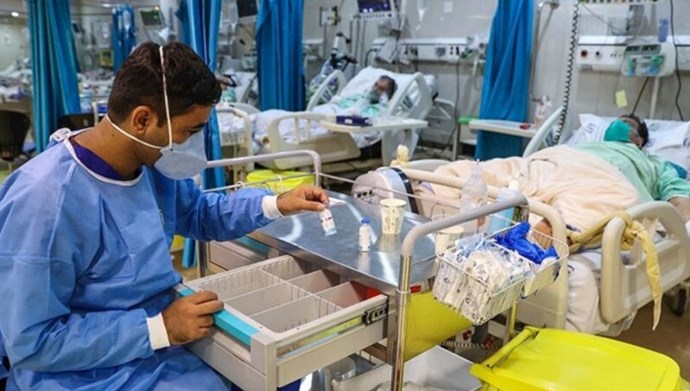Analysis by PMOI/MEK
Nov. 4, 2018 – Iran’s recent terrorist disaster in Denmark and the following ridiculous excuses by its officials speak volumes about the fragility and mayhem in the regime’s ranks and files. Nevertheless, while both factions tried to cover up and save face, their particular responses help us learn where they truly stand.
Iran’s first channel television broadcasted on October 31 the comments of the Iranian Foreign Ministry’s spokesperson, Bahram Qasemi, saying that the blame of the plot lies on other people which he himself even couldn’t say who or where they are.
“This terrorist act has been planned and plotted by the opposition and some terrorist groups in Europe, and some opposition circles in the region and the U.S. There is no doubt that the U.S., despite all these investments, efforts, and the utilization of terrorist groups in the region and other regions, can’t do anything useful for itself,” Bahram Qasemi said.
After Qasemi, Rouhani’s chief of staff, Mahmoud Vaezi, told the press that some parties are trying to derail the Iran-Europe JCPOA negotiations.
“The president has immediately ordered us to investigate what is going on. What appears in the news is very suspicious. On the eve of November 5, when the new sanctions will be implemented against Iran, some [people] are seeking to change the climate. Some [people] want to somehow disrupt the Iranian-European ties and the JCPOA negotiations which are going very well,” Iran’s ISNA news agency reported on October 31.
“We will announce [the results] as soon as our investigations and reviews in this regard are completed”, he added.
While Vaezi, like every Iranian official, tries to free the regime from blame, he intends to point the finger at “rogue” figures. This reminds us of the same game plan Iran played when they attacked the English and Saudi embassies in Tehran.
The picture of some rogue figures—who the Iranian regime tries to paint as close to the Supreme Leader Ali Khamenei and opposed to Rouhani’s so-called moderate policies towards the West—has immediate benefits for the ruling establishment regardless of their factions.
The implication is that Rouhani and the so-called moderates are genuinely trying to curb Iran’s aggressive ambitions and terrorist activities in the region and around the world, and they face opposition inside Iran. They argue that it makes no sense to sanction Iran, because this would strengthen the hardliner’s position and push back against Rouhani.
While the logic behind this line of reasoning seems to make sense at first glance, it couldn’t be farther from the truth. As discouraging as it sounds, there are no moderates in Iran, just wolves in sheep’s clothing.
U.S. Secretary of State Mike Pompeo described the situation very articulately: “Despite the regime’s clear record of aggression, America and other countries have spent years straining to identify a political moderate. It’s like an Iranian unicorn.”
“Some believe that President Rouhani and Foreign Minister Zarif fit that bill. The truth is they are merely polished front men for the ayatollahs’ international con artistry,” he added.
In fact, just a glance at some of Iran’s officials, who run as moderates, reveals the truth.
Hassan Rouhani was famously the official responsible for enforcing mandatory hijab in various Iranian government institutions after the 1979 revolution.
In his “Memoirs of Dr. Hassan Rouhani; Vol. 1: The Islamic Revolution,” he famously boasted: “The women employees… started moaning and making an uproar, but I stood firm.”
From 1989 until 2005, Hassan Rouhani was also Secretary of the Iranian regime’s Supreme National Security Council. In 1999, during the student protests in Iran, Rouhani publicly called the protest organizers “bandits and saboteurs”, promising to charge the leaders as “mohareb” (enemy of God) and “mofsed” (corrupt on earth), crimes punishable by death in the Islamic Republic. “The Velayat [i.e. the ideology that Iran’s Supreme Leader’s rule is based upon and the ideologic foundation of the regime’s export of terrorism] is the symbol of the nation’s might. Insulting the velayat is insulting the nation and all Muslims,” he said.
What followed was a brutal crackdown of the student protests.
Rouhani’s current minister of communications, Mohammad-Javad Azari Jahromi, is a former employee of Iran’s notorious intelligence ministry. According to reports, he has interrogated detained students and protesters.
It may sound unbelievable and outrageous, but Mostafa Pourmohammadi, Rouhani’s minister of justice from 2013 until 2017, was one of the central figures of the 1988 massacre of Iranian prisoners. The list goes on.
In short, the whole point of pretending that two political factions exist in Iran that oppose each other in more than having the lion’s share of the Iranian economy (e.g. in their support of terrorism and their record of human rights abuses) isn’t supported by facts and is partly rooted in wishful thinking to avoid conflict but also in short term economic and political partisan interests that will have disastrous strategic consequences both regionally and globally.





